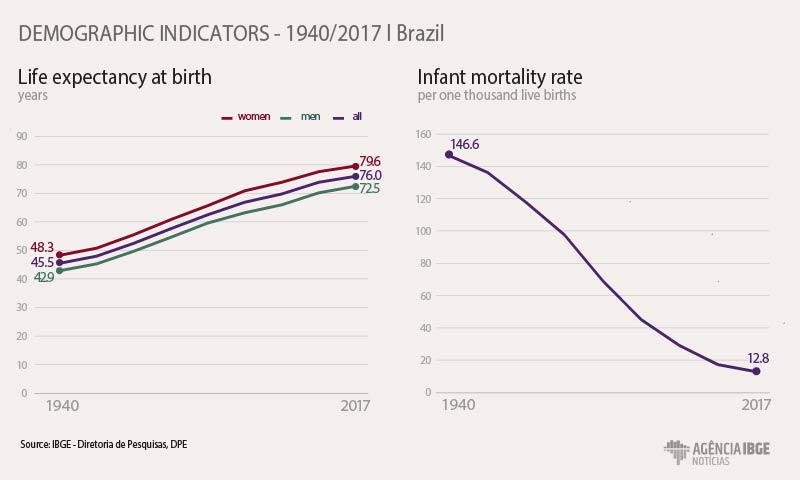Complete Life Tables
Life expetancy at birth of Brazilians increases to 76 years of age; infant mortality records decrease
November 29, 2018 09h00 AM | Last Updated: December 06, 2018 10h56 AM

Life expectancy at birth remained on an upward trend in Brazil in 2017, reaching 76 years of age, versus 75.8 years of age, in 2016, according to the Complete Life Tables, released today by the IBGE. Improvement was also observed in infant mortality rate (probability of death of a child up to one year of age), which was 12.8 per every one thousand live births, versus 13.3 in the previous year.

Life expectancy among women reached 79.6 years and remained higher than that of men, which was 72.5 years of age. By area, Santa Catarina recorded the highest life expectancy (79.4 years of age), followed by Espírito Santo (78.5 years of age), Federal District (78.4 years of age) and São Paulo (78.4 years of age). Besides those, Rio Grande do Sul (78.0 years of age), Minas Gerais (77.5 years of age), Paraná (77.4 years of age) and Rio de Janeiro (76.5 years of agre) are the only ones with indicators above the national average. The other extreme presents, with lowest life expectancy figures, Maranhão (70.9 years of age) and Piauí (71.2 years of age).
“We may still have some extra time in terms of life expectancy. In Brazil, we tend to move towards figures of developed countries, which have figures about 83 years of age. That is a considerable difference when we consider there are countries with figures around 50 years of age. We see we are closer to the higher figures”, says Marcio Minamiguchi, a researcher from the IBGE.
There is a tendency to continued and gradual increase, though more slowly, once the leap observed in the past resulted from the decline in infant mortality figures. “At first, gains were due to the decrease of mortality among younger generations, due to the types of death. That does not demand many technological advances, for example, it is enough to know that children should drink potable water. Homemade ORS was very significant in the 1980s”, Minamiguchi adds.
Infant mortality rate, however, remained n a downward trend in 2017: from 13.3 per every one thousand live births in 2016 to 12.8. Decrease was also observed in the mortality in the group aged 1 to 4, 2.16 in 2017. The trend, according to Minamiguchi, is to have deaths concentrated in children up to one year of age, due, predominantly, to congenital reasons such as malformation.
“In the group aged 1 to 4 anos, there is a predominance of causes related to the environment of the child's place of living, for example, the lack of basic sanitation services. lIn the group up to 1 year of age, many deaths take place in the first few weeks of life, and are mainly caused by congenital reasons”.
The decrease of infant mortality in the last seven weeks has beed deeply related to the increase of life expectancy. While infant mortality fell from 146.6 (1940) to 12.8 (2017), life expectancy at birth increased from 45.5 (1940) to 76 years of age (2017).



















